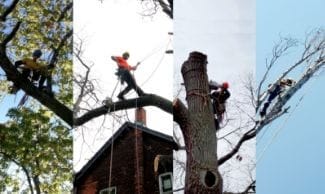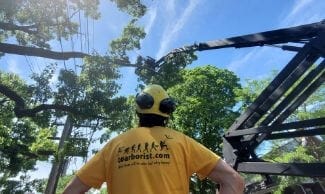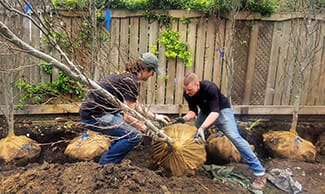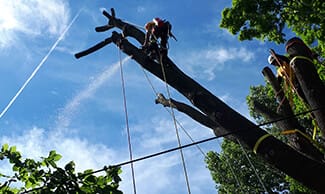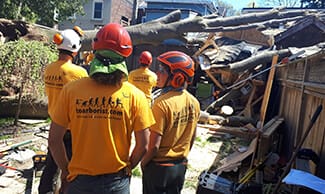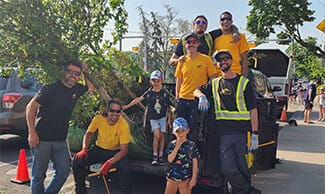Frequently asked questions
If you’re a homeowner (or manager of a property), you’re likely to have questions about how the trees on your property can be kept healthy. As Board Certified Master Arborists, we’re here to provide answers! Read on for professional advice on keeping your trees happy:
When planting a tree, it’s important to allow its roots enough time to begin good growth. In extreme hot or cold temperatures, roots can dry or freeze up, causing your tree’s foundation to fail. Because of this, Spring and Fall are often recommended for planting time. However, the roots have more guaranteed warm weather during Spring, and therefore the tree has a better chance of survival.
Recommended runing frequency depends on tree species, age, and environment. Young trees need formative pruning in the first 5 years. After Establishment, trees need to be pruned every 3–5 years, not 1–3 years. When pruning, target dead, damaged and crossing or rubbing branches. Only prune what’s necessary, as excessive pruning stresses trees.
Pruning is an important part of encouraging tree growth. The best time to prune a tree depends on the type of tree. Typically, we recommend pruning while the tree is in its dormant state, meaning they aren’t in a season of growth. This commonly occurs during the changing of the seasons (Spring and Fall). The best way to know when to prune, however, is to research the type of tree, or to give Heritage Tree Care a call!
Concerned your tree might be sick? Look for a thinning canopy, stunted leaf growth, wilting, yellowing leaves, dead branches, cracks or holes in the bark or trunk, dropped branches, stunted leaf growth, fungi growth, and frass (dropping left behind from boring insects, like termites) or sap seepage. These suggest disease, pests, or root problems negatively impacting your tree’s health.
At Heritage Tree Care, we are prepared to help you nurse your tree back to health. Important note: Tree removal is always our last resort.
There are several reasons your tree may not be blooming— it really depends on the varietal. If the tree wasn’t pruned at the appropriate time, or incorrectly, it may not bloom. For example, if your tree blooms in the spring and you prune it in early spring, it will likely not bloom as well as it should. A lack of nutrients could also reduce blooming. These issues can be easily diagnosed and addressed by your local HTC arborist.
It’s important to note that most fully mature trees will not need fertilization unless they are having growth problems. For younger trees, fertilization provides the nutrients needed to grow and bloom. Typically, you would fertilize in the spring to support the tree during the growing season. You would fertilize in the fall to pump nutrients back into the sun-soaked soil. Choosing the right fertilizer is important. We’re here to support you in making the right choices for your particular tree needs.
Winter isn’t just hard on us here in Canada, it’s hard on our trees as well! By adding mulch to the surrounding area, you provide the tree with a little insulation and a moisture-retaining layer of protection. But what is the proper mulching method? You should apply 2–4 inches of organic mulch within the dripline – that area under the outer edges of the tree’s branches and where they reach. You’ll want to leave several inches of bare soil around the trunk. Mulch retains moisture, suppresses weeds and grass, moderates soil temperature, and adds nutrients as it decomposes. Avoid mulch mounded against the trunk, as this might cause decay. After this initial process, you’ll want to rake and replenish mulch annually.
There are endless benefits to having a tree in your yard, including the following:
- They add character and curb appeal to your home, thereby Increasing property value.
- Improved air quality.
- Reduced rain runoff, protecting other plants in your garden from flooding.
- Shade from the sun.
- Attracting pollinators like bees and insects.
You may wish to try integrated pest management first, using non-chemical controls like predators, traps, or repellents. Pesticides should be selectively applied only when warranted, based on pest population monitoring. Preventively spraying pesticides leads to resistance. Have an arborist identify the pest and life stage first to target treatments to the needs of your trees.
Trees need about 1–1.5 inches of water per week from rain or irrigation. Focus water within the dripline and root zone. Soak the entire area thoroughly, not just near the trunk. Adjust your watering based on soil drainage, species, and weather. Consistent deep watering encourages deep root growth for tree health.
As trees age or endure damage, structural integrity declines. Cabling and bracing reinforces weak limbs and joints to withstand winds, storms and weight loads. This technique reduces safety hazards, avoids unnecessary tree removal, and extends the tree’s life. Periodic adjustments are needed as the tree grows, as well.
Declining trees that pose risks to your property or personal safety should be removed. We weigh factors like damage, disease level, structure and stability, and potential targets if they fall. Removal may also be needed for infrastructure damage or construction. We suggest that you try to replant a comparable tree nearby to retain canopy cover and beauty on your property.
Proper planting, mulching, pruning, and watering while trees are young is key. Conduct annual inspections for issues. Fertilize moderately in early spring. Manage pests responsibly when detected. Monitor for hazards, correcting with cabling and bracing. Also, be sure to partner with a certified arborist for professional care and insight into your trees’ health!
Arborists receive specialized training on all aspects of tree health and care. We know how to accurately diagnose problems, provide appropriate treatments, and offer science-based maintenance practices for optimum tree benefits. Our expertise maximizes tree longevity, health, safety and aesthetic value.
